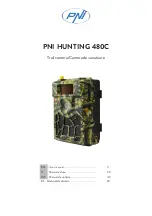
111
ķ
15.2 Manual adjustment of the flash range indication
If the camera does not send the parameterrs, the zoom position, ISO film speed
and f-stop parameters must be adjusted manually on the flash unit if the flash
range indication is to be reliable (see Chapter 6).
15.3 Exceeding the display range
The flash unit can indicate maximum flash ranges of up to 999 m or 999 ft. This
display range can be exceeded in the case of high ISO values (e.g., ISO 6400)
and large aperture openings. An arrow or triangle after the distance value indi-
cates that the display range has been exceeded.
16. FE flash exposure storage
Some Canon cameras offer the possibility of FE flash exposure storage (FE =
flash exposure). This mode is supported in E-TTL flash mode.
FE flash exposure storage in E-TTL mode permits the amount of light required for
the subsequent shot to be determined and stored prior to exposure. This can be
expedient when flash exposure has to be adapted to specific details that may not
necessarily be identical with the main subject.
Set the flash unit to E-TTL flash mode (see 5.2). Focus the camera’s AF sensor mete-
ring area on the zone whose flash exposure is to be predetermined. When the FE
button on the camera is actuated the flash unit will fire an FE test flash (the desi-
gnation FE may vary with individual camera models - please refer to the operating
instructions for the given camera). The electronic measuring circuit inside the
camera assesses the light reflected from the FE test flash to determine the light out-
put required for the subsequent exposure. The main subject can thereafter be focu-
sed with the AF sensor metering area of the camera. When the shutter release is
pressed the picture will be exposed with the previously determined light output.
Due to system-inherent reasons any changes in the light situation after the FE
test flash has been fired will not be taken into account when the picture is shot.
Some cameras do not support FE flash exposure storage in the “green” full
auto mode and programmed image control modes (see camera’s operating
instructions).
☞
17. Flash synchronisation
17.1 Normal synchronisation
In normal synchronisation the flash unit is triggered at the beginning of the shut-
ter time (first curtain synchronisation). Normal synchronisation is the standard
mode on all cameras. It is suitable for most flash shots. The camera, depending
on the mode being used, is switched to the flash sync speed. Speeds between
1/30 sec. and 1/125 sec. are customary (see the camera’s operating instruc-
tions). No settings are necessary on the flash unit, nor is there any display for
this mode.
17.2 Second curtain synchronisation (rear mode)
Some cameras offer the option of second-curtain synchronisation (rear mode),
in which the flash unit is not triggered until the end of the exposure time. This is
particularly advantageous when used with slow shutter speeds (slower than
1/30 sec.) and moving subjects that have their own source of light. With second-
curtain synchronisation, a moving light source will trail a light streak instead of
building one up ahead of itself, as it does when the flash is synchronised with the
first shutter curtain. Second-curtain synchronisation thus produces a more „natu-
ral“ image of the photographic situation when there are moving light sources.
Depending on its operating mode, the camera sets shutter speeds slower than its
sync speed.
On some cameras the rear function is not possible in certain operating modes
(e.g., certain vari- or subject programs, or with red eye reduction). In that case,
the rear mode cannot be selected, or the rear function is automatically cancelled
or ignored. For more information, refer to the camera’s operating instructions.
• The „REAR ON“ setting is for second curtain synchronisation.
• The „REAR OFF“ setting is for normal synchronisation.
The REAR function can be selected and set in the flash unit’s Select Menu
only when the flash unit is operated with a suitable Group B camera
(Table 1). The REAR mode is indicated on the flash unit only when it has
been set on the flash unit.
☞
706 47 0037-A3 58 AF-1 C 30.05.2007 8:52 Uhr Seite 111
















































